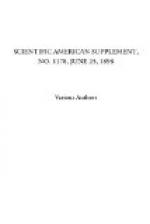This statement must bring home to you a realization of the fact that by far the most serious problem of central station management, and by far the greatest item of cost of your product, is interest on the investment. It may be that the use of storage batteries in connection with large installations will modify this interest charge, but even allowing the highest efficiency and the lowest cost of maintenance ever claimed for a storage battery installation, the fact of high interest cost must continue to be the most important factor in calculating profit and loss. This brings home to us the fact that in his efforts to show the greatest possible efficiency of his plant and distribution system, it is quite possible that the station manager may spend so much capital as to eat up many times over in interest charge the saving that he makes in direct operating expenses. It is a common mistake for the so-called expert to demonstrate to you that he has designed for you a plant of the highest possible efficiency, and at the same time for him to lose sight of the fact that he has saddled you with the highest possible amount of interest on account of excessive investment. Operating cost and interest cost should never be separated. One is as much a part of the cost of your current as the other. This is particularly illustrated in connection with the use of storage batteries. Those opposed to their use will point out to you that of the energy going into the storage battery only 70 per cent. is available for use on your distribution system. That statement in itself is correct; but in figuring the cost of energy for a class of business for which the storage battery is particularly adapted, the maximum load, that portion of your operating cost affected by the 30 per cent. loss of energy in the battery, forms under 41/2 per cent. of your total cost, and it must be self-evident, in that case at least, that the 30 per cent. loss in the storage battery is hardly an appreciable factor in figuring the operating cost of your product. So far as I have been able to ascertain, it would appear to be economical to use storage batteries in connection with central station systems the peak of whose load does not exceed from two to two and one-half hours.
In order to illustrate the important bearing which interest has on cost, I have prepared graphical representations of the cost of current, including interest, under conditions of varying load factors. For the purpose of this chart I have assumed an average cost of current, so far as operating and repairs and renewals and general expense are concerned, extending over a period of a year, although of course these items are more or less attested by the character of the load factor. For the purpose of figuring interest, I have selected seven different classes of business commonly taken by electric light and power companies in any large city. Take, for instance, an office building. It has a load factor of about 3.7 per cent., that is,




